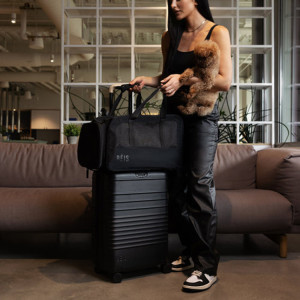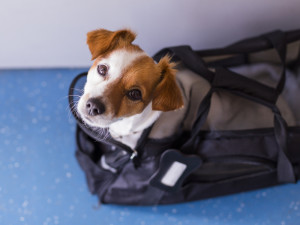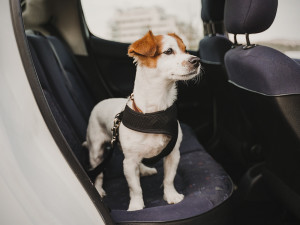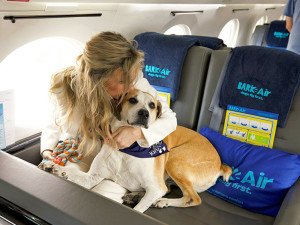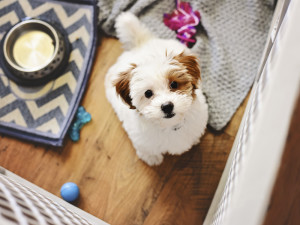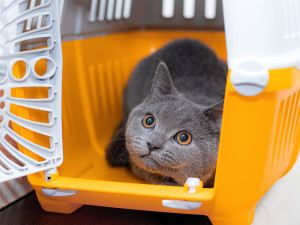Turbulence Is Getting Worse—Help Your Pet Weather the Ride
Pre-flight cuddles are OK, but the carrier is safest for your pal the rest of the trip. Here’s why.
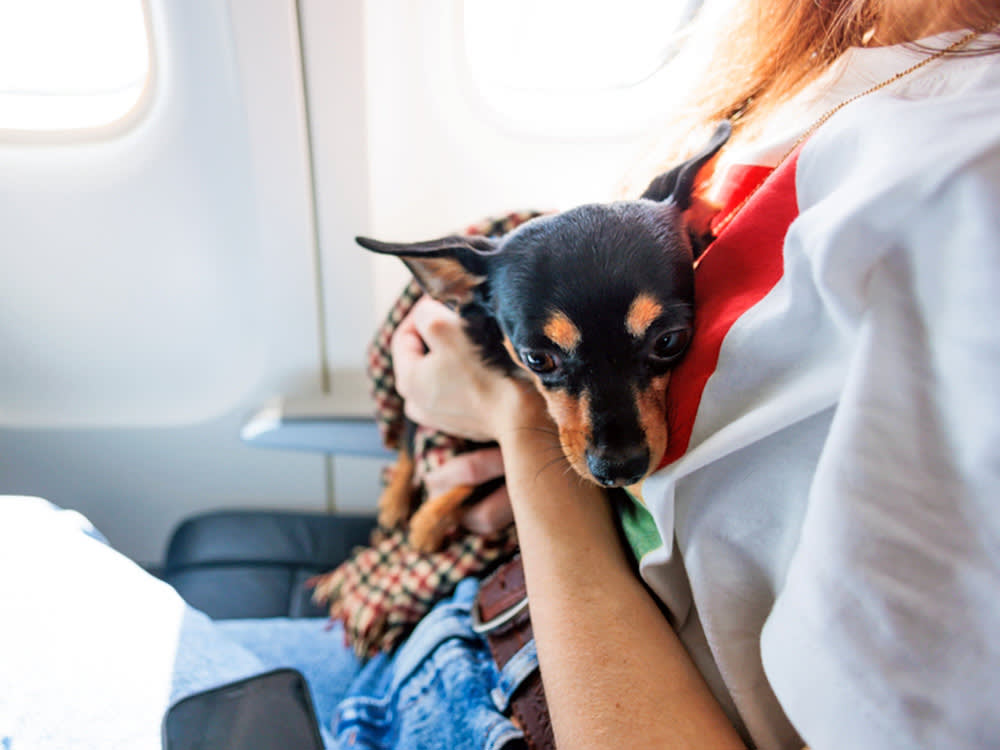
Share Article
Flying has always been kind of a pain, but there are snacks, and sometimes if you act excited enough they give you wings like you’re a small child aspiring to be a pilot. But have you noticed lately that turbulence seems to be getting worse? Not just more frequent but also more intense? As if traveling with a pet wasn’t hard enough.
And it is getting worse. According to a studyopens in new tab by scientists at the University of Reading in the United Kingdom, severe-or-greater turbulence increased by 55 percent over the North Atlantic and Continental United States from 1979 to 2020.
The reason? Climate change, which means it won’t be getting better any time soon. But there are things you can do to at least make traveling with your pet during said turbulence a little bit easier — on them and you.
Plan ahead.
Before your trip, “talk to your vet about medications to prevent nausea that are approved for cats and dogs,” says Stephen Quandt of Cat Behavior Helpopens in new tab. “Your vet can also advise you about how best to limit food and water prior to flying to reduce the risk of accidents during travel. He adds that if your pet is riding with you in the cabin, it’s important to make sure you have an airline-approved carrier that you can fit under the seat in front of you. He also recommends lining the carrier with a pee pad and making sure you have cleaning supplies (nitrile gloves, pet wipes, paper towels, and Ziplock bags).

“Make sure your dog [or cat] is familiar and comfortable with their new airline-approved carrier by using it a few times before your flight,” adds Lorraine Rhoads, director of health and safety at Dogtopia.opens in new tab “Providing a small blanket or toy with the scent of home will add additional comfort.”
Cats are almost always small enough to travel in the cabin with their people, but larger dogs often need to travel in the cargo hold. “If your pup is too large to safely travel with you in the cabin and must travel in the cargo hold, there are a few important things to plan on,” Rhoads says. She adds the following tips:
“Make sure your crate is approved for cargo-hold travel. This means it must be strong, waterproof, and large enough for your dog to stand and turn around but not so big that they could get injured in the crate if there’s turbulence.”
“Consider booking a nonstop flight on a less busy travel day to minimize stress.”
“Give your dog the opportunity to exercise before a flight to help them burn energy and stay calm while traveling.”
Give yourself plenty of time before the flight.
“Whether your pet travels in the cabin with you or in the cargo hold, you will need to make a reservation for them with the airline in advance,” says Quandt, who regularly travels by plane with his two cats, Jenny and Cricket. “I recommend calling the airline after you book your flight and confirm that your pet is included on your ticket, since you may not be able to see them on the reservation — at least not with in-cabin pets.” He also reminds pet parents they will have to pay for their pet, likely at check-in, so getting to the airport extra early is always a good idea.
Checking your pet into the cargo hold does come with risks, though. “Pets checked in to the hold are at risk of escaping or becoming lost or mishandled,” Quandt says. “This happens to a certain number of pets every year. Airlines are supposed to disclose statistics on these occurrences [although they don’t make those statistics easy to find], so think very carefully before putting your pet in the hold.”
Once you’re airborne, pets in the hold are on their own, turbulence or not, but for pets traveling with you in the cabin, there are things you can do to help them weather a bumpy ride.
“Technically, the carrier is supposed to be fully under the seat in front of you,” Quandt says. “But I’ve never had a flight attendant say anything if it’s sticking out just a little bit. And what I’ll do then is slightly unzip the top opening of the carrier and reach my hand in and touch my anxious/meowing/crying cat. This calms them down every time. Talking to them may help a little, but it’s important to remember that turbulence is not a natural experience for our pets, and there is only so much we can do for them.”
Listen to the flight attendants, and be safe.
“Be sure to follow all the recommendations provided by the flight attendants, as they are experienced in helping pet parents,” Rhoads says. “And remember to bring along a favorite toy (without a squeaker) or a chew treat that can be a distraction.”
Rhoads and Quandt are both adamant that you not take your pet out of their carrier during the flight. “From a safety perspective, keeping them under the seat in front of you protects them, as well as you and your fellow passengers,” Quandt says. “If the turbulence is so severe that things are flying around the cabin, keeping them under the seat is the only thing to prevent them from hitting the ceiling and flying around.”
If you must take your pet out of their carrier, do so only in a closed and locked lavatory. That way you do not run the risk of your pet escaping into the cabin. And make sure to close the lid of the toilet before letting them out of their cage so there is no risk of them falling (or jumping) in.
Stay calm for your pet.
When turbulence does occur, remember that your pet takes many of their emotional cues from you, so it’s important that you stay calm. “A [pet] that is anxious, worried, sick, or scared will probably show you with heavy panting, whining, lip licking, or even barking,” says Rhoads, “and these behaviors can be made worse if you are also worried.” Quandt agrees. “You aren’t helping them or yourself if you are freaking out,” he says. “Be a smart traveler: Keep your seatbelt fastened whenever you’re in your seat and your pet safely in their carrier.”
Remember that even the worst turbulence doesn’t last long. Just prepare and be there for your pet as best you can in the moment and you’ll both be fine.
References:
Evidence for Large Increases in Clear-Air Turbulence Over the Past Four Decadesopens in new tab

Charles Manning
Charles Manning is an actor and writer based in New York City. In his free time he likes to cook, go swimming at the public pool, volunteer at the LGBTQ senior center, and foster senior and special-needs cats. His work has previously appeared in Cosmopolitan, Elle, Marie Claire, Harper’s Bazaar, Seventeen, and Nylon.
Related articles
![BARK Air is here to deliver a white paw experience. We built our flight experience for dogs first, from the ground up.]()
BARK Air Is a New Dog-Friendly Airline—But the Prices Are Sky High
Your dog will get their own puppy concierge to make sure all their in-flight needs are met.
![A cute puppy looking up at the camera]()
When it Comes to Dog Crates, Think Outside the Literal Box
How to treat and prevent confinement anxiety.
![Gray cat in a yellow pet carrier]()
How to Prepare Your Pet for a Natural Disaster
The East Coast just had a rare earthquake. A vet breaks down what to include in an emergency go-bag for your pet in times like this.
